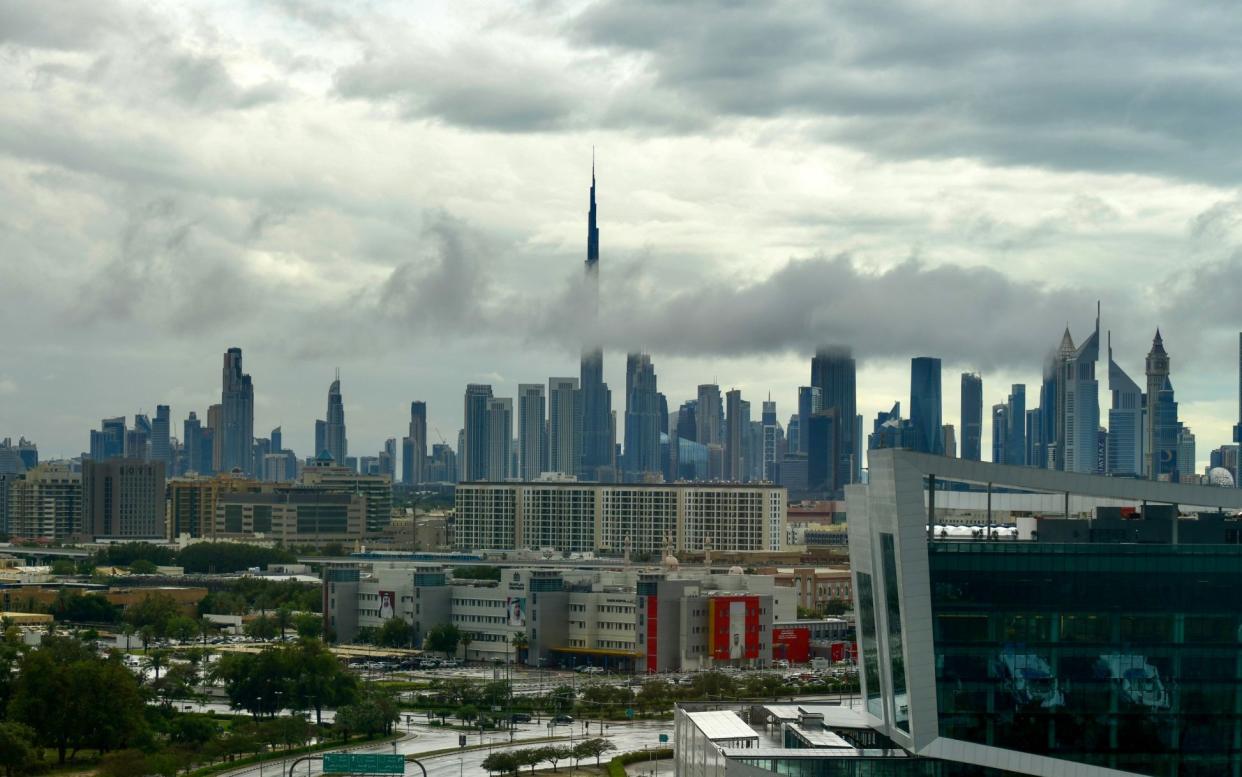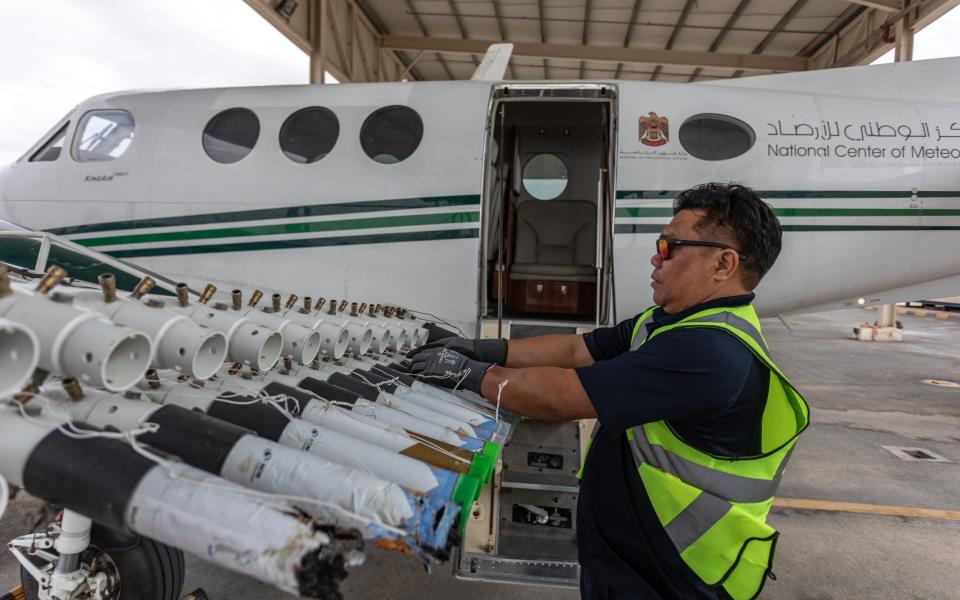The British scientists plotting to control the world’s weather

- Oops!Something went wrong.Please try again later.

In summer 2017, a delegation of visitors from the United Arab Emirates flew into the Berkshire town of Reading.
They had not come for a sightseeing tour, but to discover how scientists at the university were progressing with the small matter of controlling the weather.
Earlier that year, the University of Reading had been awarded a $1.5 million share of a $5 million fund allocated by the UAE Research Program for Rain Enhancement Science.
Now, members of the UAE programme had arrived to observe the initial results of a project designed, quite literally, to make it rain.
While most Britons would prefer scientists to work on stopping it from pouring, drier parts of the world – the UAE included – understandably have other goals.
Accordingly, the five-strong team at Reading’s Department of Meteorology have been investigating how spraying electric charge into clouds could induce rain in regions that experience very little rainfall.
The idea of effectively playing God to influence the weather is not a new one. Already in the UAE and elsewhere, older “cloud seeding” technology is being employed – a practice that involves manipulating existing clouds to help precipitate more rainfall.
Generally, it involves spreading fine particles, such as silver iodide, salt or dry ice, into the clouds to help water vapour condense and turn into rain.
The scheme being developed by the Reading scientists involves using drones to release electric charge into clouds. Dry regions such as in the Middle East and North Africa could benefit, the university says.
If it sounds like science fiction, earlier iterations have in fact been around since the 1940s, with the UAE employing cloud seeding extensively since the early 2000s.
But this week, as record floods bring chaos to Dubai, the practice has been thrust into the spotlight. If cloud seeding was being used to create rain in the UAE, then could it have been the cause of the rare downpour in Dubai that saw a year’s worth of rain fall in a single day?
The short answer was no, it almost certainly could not have been. “The UAE does have an operational cloud seeding programme to enhance the rainfall in this arid part of the world,” said Prof Maarten Ambaum, a Reading University meteorologist.
“However, there is no technology in existence that can create or even severely modify this kind of rainfall event.” No cloud seeding operations had taken place in the area recently, he added, and there would have been no benefit in seeding clouds that were predicted to produce substantial rain regardless.
“The [weather] system was identified in our global model, which doesn’t include any inputs on weather modifications,”
says Grahame Madge, a Met Office climate spokesman.
“So the system at least was naturally occurring.” In the usually arid Gulf State, where the mercury can rise to 50C in summer, planes regularly undertake cloud seeding. They reportedly use salt material components.
The Reading scientists, led by Prof Giles Harrison, have meanwhile been developing a different technique, in which an electric charge is applied to make droplets stick to each other and so quickly grow large enough to fall as rain. Harrison, a bespectacled atmospheric physics expert, harbours a long-standing fascination with natural science – and an enthusiasm for testing new ideas.
The technology he and his team have developed has been tested not in the deserts of the Gulf states, but in the rather greener English countryside. In 2020, at the university’s farm in Sonning, Berkshire, a first experiment was carried out by Harrison’s team, alongside mechanical and electrical engineers from the University of Bath, in which charge was released into fog using electric emitters.
The following year, further tests were performed at Bottom Barn Farm near Castle Cary in Somerset. Here, above a verdant landscape rarely troubled by drought, unmanned aerial vehicles with specially developed charge emitters that could release positive or negative ions on demand were launched into another foggy sky.
It was, wrote Reading’s Dr Keri Nicoll afterwards, “an important first step in determining whether charging cloud droplets might be helpful in aiding rainfall in water-stressed parts of the world”.
The test flights demonstrated that the fog’s droplet size could be altered by charging, “which ultimately means that it may be possible to use charge to influence cloud drops and thus rainfall,” wrote Nicoll.
She told The National, a UAE newspaper: “What we’re doing here is something that’s completely different. We are using very small aircraft, which means that things are actually much more cost effective, and we’re simply charging up what’s already there.”
The promise behind charging droplets, or particles, was that the technique might well work alongside the existing cloud-seeding operation, making it more efficient at producing rainfall, she said.

Some 2.3 billion people live in water-stressed countries globally, according to the United Nations, while 3.2 billion live in agricultural areas with high water shortages or scarcity.
The Reading scientists hope that research into the properties of clouds and rainfall could eventually help prevent conflict over water in such places and provide enough water for a growing world population.
The Reading scientists have also carried out fieldwork studying desert rainfall and effects of sea breezes in the Gulf, and sent specially instrumented weather balloons through the fogs of Abu Dhabi.
The technology they have developed has yet to be deployed operationally. But, says Ambaum of its potential future benefits: “Any small improvement to the amount of rain in arid regions will be of value.”
In the UAE, it is hoped that the innovation could help the state grow its own crops and produce fresh water.

There is a caveat, though. “Note,” Ambaum says, “that if there are no clouds, then you cannot have cloud seeding. That excludes quite a lot of arid regions of the world.”
While the scientific consensus is that the cloud seeding already in use in the UAE would not have caused the floods, are there other risks associated with the practice? Ambaum suggests not.
It occurs on small space scales (the size of individual convective clouds) and short time scales (about an hour or so, the time for cloud microphysical effects to take place). “Any interventions are therefore very limited in space or time,” he says.
“This is not weather modification. We cannot change the evolution or intensity of weather systems… It is also not climate engineering: any effects are limited in time and space.”
The materials used for cloud seeding have very low concentrations, moreover, and cause no adverse health effects, he adds.
The electric charge used in the team’s research does not distribute any material into the environment at all, and as the drones used to release the charge are battery-operated, no pollution is created from propelling the aircraft. The charge released dissipates naturally.
“This means Harrison and his team have developed a more environmentally-friendly method of weather modification, which could in principle operate automatically from multiple sites,” says the university.
As for what did cause the flooding in Dubai, it seems the answer might be a more familiar one.
“When we talk about heavy rainfall, we need to talk about climate change,” said Dr Friederike Otto, senior lecturer in climate science at Imperial College London.
“If humans continue to burn oil, gas and coal, the climate will continue to warm, rainfall will continue to get heavier and people will continue to lose their lives in floods.”

